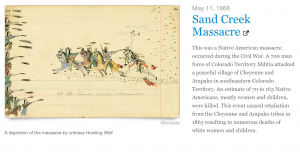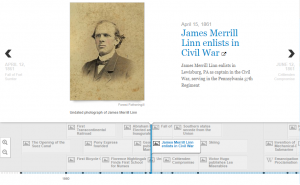TimeMapper is a great tool for organizing and representing events. Through TimeMapper, we can organize informations into a timeline of significant events. We often think of time as a linear line, however, time is nonlinear (Grafton, 20). Historical events usually don’t start and end in a linear fashion. There are many events happening at the same time with different causes and ends. Using timelines, we can illustrate time as an order of events.
Above is our TimeMapper of the 1860s. The key idea of chronographic is not to design “more complex visual schemes” but rather to “simplify” it (19). By treating time as a linear line, we can see the connections between different events in an era. For example, we often relate the 1860s to the civil war but there were a lot more happening in the 1860s than the Civil War. The Civil War took about 4 years from 1861 to 1865. There were also the American-Indian Wars and the inventions of telegraph and dynamite which we are oblivious to. Using TimeMapper, we can understand a lot more about the 1860s. Like Linn, we are confined to a certain amount of informations which we can only experience personally. In the diary, Linn was oblivious to the world around him. He was only concern with what he was personally experiencing. With the help of timelines, we can study history more chronologically correct.
 This is an example of many events that are significant but not directly correlated with the Civil War. Since time is nonlinear (20), the connection between events in a timeline is not easy to grasp. Grafton stated in his article that “the line can be everywhere because it is so flexible and its configurations so diverse” (13). We don’t usually associate the Indian War with the 1860s since the Civil War was considered more significant. Seeing the orders of events of the Civil War and this massacre, we can make the connection between the Civil War and the Indian Wars.
This is an example of many events that are significant but not directly correlated with the Civil War. Since time is nonlinear (20), the connection between events in a timeline is not easy to grasp. Grafton stated in his article that “the line can be everywhere because it is so flexible and its configurations so diverse” (13). We don’t usually associate the Indian War with the 1860s since the Civil War was considered more significant. Seeing the orders of events of the Civil War and this massacre, we can make the connection between the Civil War and the Indian Wars.





 the time when Linn was writing his diary. The creation and study of our completed timeline made me realize a few things. For example, it’s very easy to get wrapped up in a particular set of events. As a result, it can be difficult to recognize, or pay significant mind to, larger events going on around the same time. When reading Linn’s diary, I found myself forgetting that he was writing about events in a small corner of the Civil War. Opening up the scale and comparing his story to the rest of history really put his story into perspective. The scale of a historical graphic really depends on how detailed you make it, represented well by the annals from the 700s in Grafton’s essay.
the time when Linn was writing his diary. The creation and study of our completed timeline made me realize a few things. For example, it’s very easy to get wrapped up in a particular set of events. As a result, it can be difficult to recognize, or pay significant mind to, larger events going on around the same time. When reading Linn’s diary, I found myself forgetting that he was writing about events in a small corner of the Civil War. Opening up the scale and comparing his story to the rest of history really put his story into perspective. The scale of a historical graphic really depends on how detailed you make it, represented well by the annals from the 700s in Grafton’s essay.

